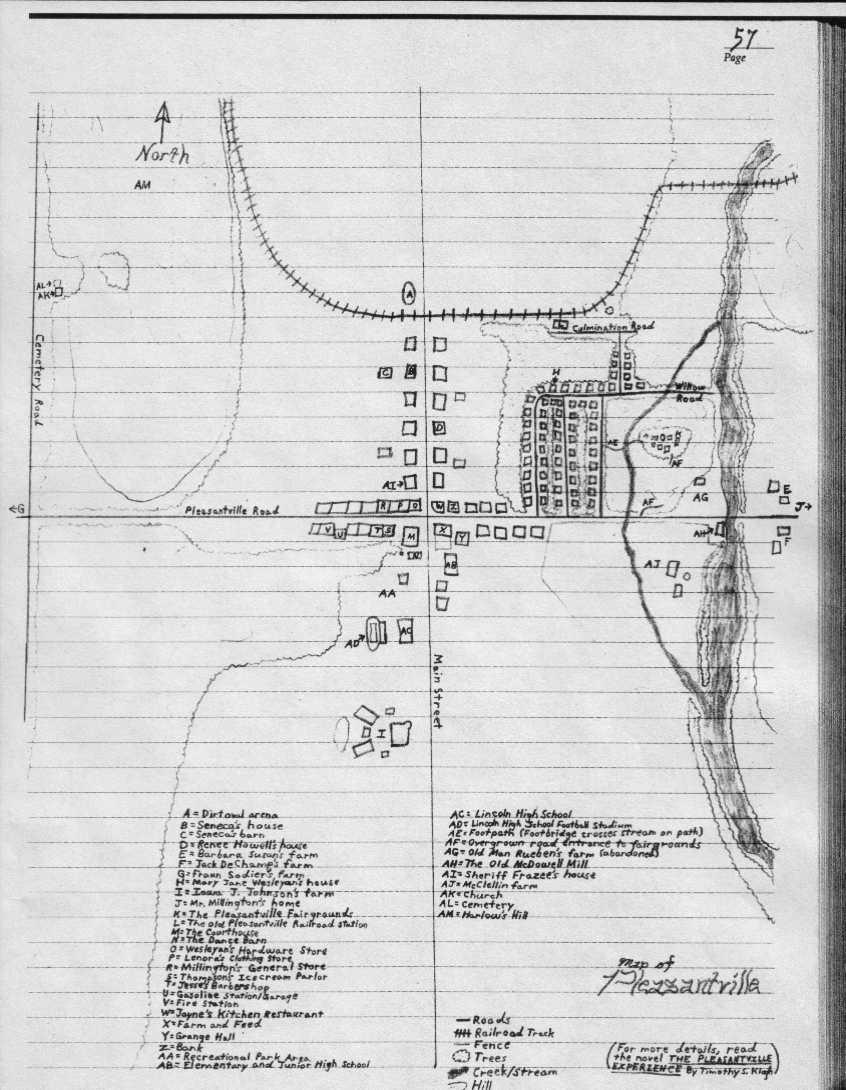
A few extra bits of information about Pleasantville
The novel covers a lot of information about
the Town of Pleasantville, but there are a few things that it never gets
around to explaining. The author has given a few explanations (to
the best of his knowledge) about Pleasantville that might be inquired from
the curious-minded. These explanations are below:
Who uses the dirt oval arena north of town?
"The dirt oval arena was regularly used by horse riders in the town.
Barbara Susan and Fraun Sodier would ride there frequently. Iowa J.
Johnson preferred to ride on his farm." -- author
Were there any other families of prominence in
town other than the Johnsons?
"The three most prominent families in and around Pleasantville were
the Johnsons, Sodiers and McClellins. Iowa's family owned the most
property which landlocked Pleasantville on the southern border. The
Sodiers owned the second largest farm which was located a good ways west of town down
Pleasantville Road. The McClellins owned the third largest farm which was
just south of Pleasantville Road on the east side of town." --
author
Who were the McClellins?
"The McClellins
generally kept to themselves and would raise a large fuss when their land
was trespassed upon. It is rumored that their anger stems from their land
being landlocked by Pleasantville, the Johnson farm, and the DeChamp farm.
It is also rumored that the McClellins were angry because they were never
able to acquire Old Man Rueben's farm, which had been abandoned for 50
years. One of the McClellins do appear in the novel under the name
Macallin.
Keith Seneca had once dated their daughter, Julie Macallin." -- author
The Seneca's owned a farm, but yet their farm
house was among a row of houses on Main Street. Could you explain
this?
"Only four of the houses on Main Street north of Pleasantville Road own
the vast area of land behind the houses. Those four houses that own the
land are actually farms that were located there prior to the other houses
being built next to them. The four houses that are actually farms can be
identified on the map above by the barns that are located behind them.
There are two farms on the west side of Main Street and two farms on the
east side of Main Street. For example, the Seneca's house is on a farm
and Renee Howell's house is not on a farm." -- author
Why is there a group of small houses crowded
together on the east side of town?
"The neighborhood of small houses where Mary Jane Wesleyan lived
developed during the years when people would take the train in and out of Pleasantville. Culmination Road was never extended to Main Street (most
likely due to protests from property owners on Main Street) so most of the
traffic flow went straight down to Pleasantville Road. The neighborhood
of small houses came into existence as a result of the convenient proximity
to town, the railroad station and the Pleasantville Fairgrounds. When the
railroad station closed (and the Pleasantville Fairgrounds stopped
operating shortly afterward,) the neighborhood became a very quiet one.
The woods continued to grow and nestled around it. The houses on Main
Street and Pleasantville Road are much older and larger than the houses in
this neighborhood." --author
The railroad tracks take a drastic curve near
Pleasantville? Wouldn't that have been replaced with a new alignment
after the railroad station closed?
"Probably so. Trains had become infrequent to come down the tracks near Pleasantville. It
is very likely that there was a busier alternative line elsewhere that
bypassed Pleasantville.
Perhaps the railroad tracks near Pleasantville were used on an 'as needed'
basis by the
railroad." --author
Why is the church located so far outside of Pleasantville?
"I don't
know. Pleasantville is certainly a God-fearing community, so I have no
idea why the church is so far away. Perhaps there were several
churches around Pleasantville at one time but the one on Cemetery Road had
the minister that everyone liked most." -- author
Were there any other roads in Pleasantville
than what was shown on the map?
"Other than gravel drives and dirt ruts around the commercial buildings that
was
all the roads that I remembered were in town. Keep in mind that Pleasantville
was
completely surrounded by farms. There was no room to grow. But, I
don't think the people of the town minded." --
author
Why is Harlow's Hill called Harlow's Hill?
"Harlow's Hill was named many years ago for the farmer who once owned the
northern half of the hill. Harlow was not known of much about in
current times
other than the fact he had a hallow face and kept trespassers off his land
with a shot gun." -- author
What is the story of Old Man Rueben's Farm?
"Old Man Rueben died 50 years before Timothy Reye ever came to
town. Rueben was already an old man when anyone still alive in town
remembered seeing him. Old Man Rueben was a World War I Veteran who
was a German soldier in the war. He came to Pleasantville with
very little money and purchased a portion of the woods north of
Pleasantville Road. He cleared out the trees and made himself a
small farm. He then took care of his own business running his farm
and was reclusive to the townspeople. The last thing he wanted was
to draw attention to himself. He never married and he never had
children. When he died, his farm became the property of
Pleasantville. The municipality decided to just leave his farm alone
and let the woods reclaim it." -- author
|